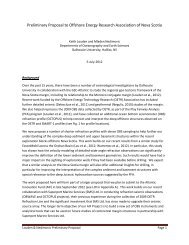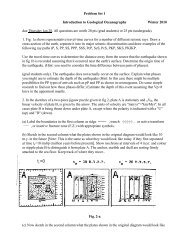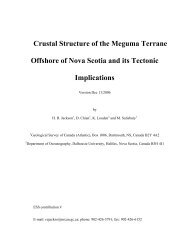the stratigraphy and structural history of the mesozoic and cenozoic ...
the stratigraphy and structural history of the mesozoic and cenozoic ...
the stratigraphy and structural history of the mesozoic and cenozoic ...
Create successful ePaper yourself
Turn your PDF publications into a flip-book with our unique Google optimized e-Paper software.
deposited in <strong>the</strong> deepwater. As with previous periods <strong>of</strong> high rates <strong>of</strong> deposition into <strong>the</strong><br />
deepwater, <strong>the</strong> increased sediment load in <strong>the</strong> Early Cretaceous initiated renewed salt<br />
motion, resulting in salt withdrawal mini-basins that formed negative relief structures on<br />
<strong>the</strong> seafloor in which turbidite channel <strong>and</strong> fan sediments were focused <strong>and</strong> deposited<br />
(Kidston et. al., 2002). Fur<strong>the</strong>r south <strong>the</strong> Shelburne Delta became ab<strong>and</strong>oned due to<br />
exhaustion <strong>and</strong>/or redistribution <strong>of</strong> <strong>the</strong> fluvial sediment supply (Kidston et. al., 2002).<br />
Deltaic sedimentation ceased along <strong>the</strong> entire Scotian margin during <strong>the</strong> Late<br />
Cretaceous <strong>and</strong> was followed by a period <strong>of</strong> slow relative sea level rise <strong>and</strong> deposition <strong>of</strong><br />
a thick succession <strong>of</strong> coastal plain <strong>and</strong> shallow marine shelf s<strong>and</strong> <strong>and</strong> shale <strong>of</strong> <strong>the</strong> Logan<br />
Canyon Formation. No regional seismic markers are contained within <strong>the</strong> Logan Canyon<br />
Formation (MacLean <strong>and</strong> Wade, 1992). The distal equivalent <strong>of</strong> <strong>the</strong> Logan Canyon<br />
Formation is <strong>the</strong> Shortl<strong>and</strong> Shale. Within <strong>the</strong> study area drilled thickness <strong>of</strong> Logan<br />
Canyon Formation (or equivalent) range from 776.3 m in well Moheida P-15 to 2220.0 m<br />
in well Evangeline H-98 (MacLean <strong>and</strong> Wade, 1993).<br />
Continued relatively high sea level conditions combined with low relief<br />
hinterl<strong>and</strong>, resulted in a reduction <strong>of</strong> sediment supply to <strong>the</strong> basin during <strong>the</strong> Late<br />
Cretaceous (Kidston et. al., 2002). Marine shales, chalks <strong>and</strong> minor limestones <strong>of</strong> <strong>the</strong><br />
Dawson Canyon Formation were deposited throughout <strong>the</strong> Scotian Basin at this time. The<br />
Petrel Member, a persistent series <strong>of</strong> thin Turonian age limestones, forms a regional<br />
lithologic <strong>and</strong> seismic marker within <strong>the</strong> Dawson Canyon Formation (Wade, 1991). The<br />
Dawson Canyon Formation was intersected in all six wells used in this study <strong>and</strong> has a<br />
30









